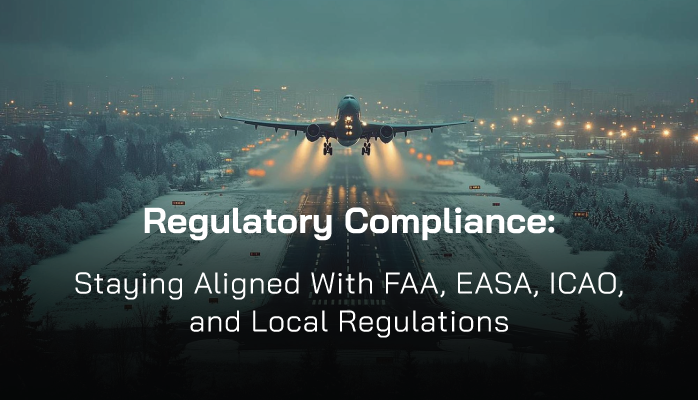Staying Aligned With FAA, EASA, ICAO, and Local Regulations

Aviation safety managers operate in a highly regulated environment where compliance with global and local standards is non-negotiable.
Regulatory bodies like the Federal Aviation Administration (FAA), European Union Aviation Safety Agency (EASA), International Civil Aviation Organization (ICAO), and local authorities set stringent guidelines to ensure
- safety,
- operational efficiency, and
- public trust.
Staying aligned with these regulations is a complex but critical task. This article explores the importance of regulatory compliance, key challenges, and practical strategies for aviation safety managers to maintain adherence while optimizing operations.
Why Regulatory Compliance Matters
Compliance with FAA, EASA, ICAO, and local regulations is the backbone of aviation safety. These regulations cover aircraft maintenance, pilot training, air traffic control, and operational procedures, ensuring that every aspect of aviation minimizes risks. Non-compliance can lead to severe consequences, including:
- Safety Risks: Deviations from standards can compromise passenger and crew safety.
- Financial Penalties: Fines for non-compliance can reach millions of dollars, as seen in FAA enforcement actions.
- Reputational Damage: Violations erode trust among passengers, partners, and regulators.
- Operational Disruptions: Grounded aircraft or suspended operations can cripple airlines or operators.
For safety managers, staying compliant is not just about avoiding penalties—it’s about fostering a culture of safety and operational excellence.
Understanding Key Regulatory Bodies

Each regulatory body has distinct yet overlapping roles. Here’s a breakdown of their scope and focus:
1. Federal Aviation Administration (FAA)
The FAA, based in the United States, oversees aviation safety, air traffic control, and certification. Its regulations, outlined in the Code of Federal Regulations (CFR) Title 14, cover everything from aircraft design to pilot licensing. Key areas for safety managers include:
- Part 121: Standards for commercial air carriers.
- Part 145: Repair station regulations.
- Safety Management Systems (SMS): Mandatory for Part 121 operators to proactively manage risks.
2. European Union Aviation Safety Agency (EASA)
EASA harmonizes aviation standards across EU member states. Its regulations, such as Regulation (EU) 2018/1139, emphasize airworthiness, crew licensing, and environmental protection. EASA’s focus on Continuing Airworthiness Management Organizations (CAMO) requires safety managers to ensure ongoing compliance with maintenance and operational standards.
3. International Civil Aviation Organization (ICAO)
ICAO, a UN agency, sets global standards through its Annexes to the Chicago Convention. While ICAO standards are not legally binding, they form the basis for national regulations. Safety managers must align with ICAO’s Standards and Recommended Practices (SARPs), particularly in areas like SMS, runway safety, and fatigue management.
4. Local Aviation Authorities
Local regulators, such as the UK’s Civil Aviation Authority (CAA) or India’s Directorate General of Civil Aviation (DGCA), adapt global standards to regional contexts. Safety managers must navigate these localized requirements, which may include unique reporting protocols or language-specific documentation.
Challenges in Maintaining Compliance
Aviation safety managers face several hurdles in aligning with these regulations:
- Regulatory Complexity: The sheer volume of regulations—FAA’s CFR alone spans thousands of pages—can overwhelm teams. Keeping up with frequent updates, such as EASA’s amendments or ICAO’s revised SARPs, adds to the challenge.
- Global Operations: Airlines operating internationally must comply with multiple jurisdictions simultaneously, each with distinct requirements.
- Resource Constraints: Smaller operators may lack the budget or staff to implement robust compliance programs.
- Evolving Technology: New technologies like drones and electric aircraft introduce novel regulatory demands.
- Human Factors: Staff training and fatigue management must align with regulations, but human error remains a persistent risk.
Related Human Factors Articles
- Let’s Talk Human Factors - Origin of Dirty Dozen
- Let’s Talk Human Factors - Lack of Communication
- Let’s Talk Human Factors: Distraction Is #4 of the Dirty Dozen
Strategies for Effective Compliance
To overcome these challenges, aviation safety managers can adopt the following strategies:
1. Implement a Robust Safety Management System (SMS)
An SMS is a structured, top-down approach to managing safety risks, mandated by both FAA and ICAO. Key components include:
- Risk Assessment: Identify and mitigate hazards before they escalate.
- Safety Reporting: Encourage staff to report issues without fear of reprisal.
- Data Analysis: Use incident data to drive continuous improvement.
- Safety Communications: Develop just culture to support safety awareness.
By integrating SMS into daily operations, managers can ensure alignment with regulatory requirements while fostering a proactive safety culture.
2. Stay Updated on Regulatory Changes
Regulations evolve rapidly. To stay informed:
- Subscribe to FAA’s Aviation Safety Information Analysis and Sharing (ASIAS) for real-time updates.
- Monitor EASA’s Safety Publications and ICAO’s Electronic Bulletin.
- Attend industry conferences like the Aviation Safety Summit to network with regulators and peers.
3. Leverage Technology for Compliance
Compliance management software, such as SMS Pro, streamlines tasks like document control, audit preparation, and training tracking. These tools ensure that records are audit-ready and accessible, reducing the risk of oversight.
4. Conduct Regular Audits and Training
Internal audits are critical for identifying gaps before external inspections. Schedule quarterly audits aligned with FAA, EASA, or local checklists. Complement audits with ongoing training programs to keep staff updated on regulations like crew rest requirements or maintenance protocols.
5. Collaborate With Industry Partners
Engage with industry groups like the International Air Transport Association (IATA) or Airlines for America (A4A). These organizations provide resources, such as compliance templates and best practices, to simplify adherence.
6. Prepare for Multi-Jurisdictional Operations
For global operators, create a centralized compliance framework that maps FAA, EASA, ICAO, and local requirements. Assign regional compliance officers to handle jurisdiction-specific nuances, ensuring seamless operations across borders.
The Role of Leadership in Compliance
Safety managers must champion compliance at all levels. This involves:
- Clear Communication: Ensure staff understand regulatory obligations and their role in meeting them.
- Accountability: Hold teams accountable for compliance while rewarding adherence.
- Investment: Advocate for budgets to support training, technology, and audits.
Leadership commitment signals to regulators and employees that compliance is a priority, reducing risks and enhancing credibility.
Related Aviation Safety Manager Articles
- What Makes a Good Aviation Safety Manager?
- How to Tell If Aviation Safety Manager Is Doing Their Job?
- Career Advice for Aspiring Aviation Safety Managers
Conclusion
Regulatory compliance is a dynamic and demanding responsibility for aviation safety managers. By understanding the roles of FAA, EASA, ICAO, and local authorities, addressing challenges, and implementing proactive strategies, managers can ensure alignment with standards while prioritizing safety.
Leveraging SMS, technology, audits, and industry collaboration empowers organizations to not only meet regulatory requirements but also excel in operational performance. In an industry where safety is paramount, compliance is the foundation of trust and reliability.
Call to Action
Review your organization’s compliance program today. Conduct a gap analysis, invest in training, and explore compliance software to stay ahead of FAA, EASA, ICAO, and local regulations. A proactive approach today prevents costly penalties tomorrow. Need help or have questions? SMS Pro's experts take the pain out of managing your SMS.








